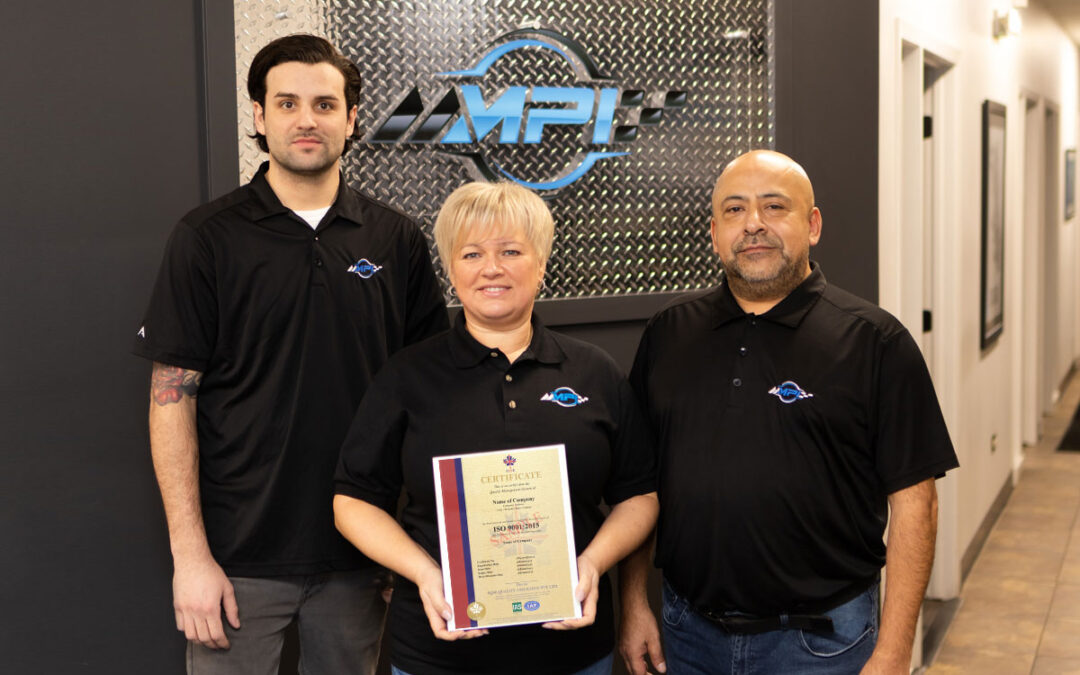ISO 9001:2015 is an internationally recognized standard for a Quality Management System (QMS). It provides a framework for organizations to consistently meet customer requirements and improve their overall performance.
Mechanical Power Inc. (MPI) has been ISO certified since 2012, but we decided to go with a higher graded ISO certification widely accepted in fields such as Automotive based on the diversification and expansion of our business in recent years.
We are thrilled to share that Mechanical Power has received this upgraded ISO 9001:2015 accreditation confirming our commitment to quality management and exceptional service delivery to our customers and stakeholders. This certification is a testament to our dedication to providing superior service and successful project outcomes.
As we continue to strive for excellence, we will build upon this achievement by working to enhance our industrial manufacturing and quality management practices.
Organizations that are certified to ISO 9001:2015 have demonstrated their ability to consistently provide products and services that meet customer and regulatory requirements. The standard is based on several quality management principles including a strong customer focus, the motivation and implication of top management, the process approach and continual improvement.
I am incredibly proud of our team for their hard work and dedication to achieving this certification,” said Sam Viana, Quality & Engineering Manager at Mechanical Power. “Our ability to deliver high-quality products is crucial to our success and this certification is a testament to the commitment of all team members to meet these standards on a daily basis.
ISO Compliant vs ISO Certification vs ISO Accreditation
ISO Compliant
Can be a self-proclaimed title, when the company in question has implemented all requirements to its best ability and claims that it is being fully or partially compliant, but it has no independent assurance.
ISO Certified
Means there is an independent certification body that provides written assurance of compliance with the specific ISO standard.
Accredited ISO certification: or to be more precise, certification by an accredited certification body, means that an independent certification body, recognized by an independent accreditation body, issued a certificate to provide written assurance of compliance.
Accreditation
The recognition and approval of a certification body by an independent accreditation body, officially recognizing that the certification body works in accordance with international standards.
What Are the Benefits of ISO Accreditation and Certification?
An organization that strived to comply with standards and get certified can reap the following benefits:
Easily prove compliance to clients and interested parties.
Being independently and globally recognized for its efforts, products, and services.
Boost assurance to customers.
Better internal management and processes.
Increased productivity, efficiency, and profit.
Guaranteed customer acquisition and retention.
It is important to understand the distinctions between ISO accreditation and ISO certification when adhering to ISO standards. Knowing how they are related and the advantages they provide is also crucial. There is often confusion surrounding the difference between ISO accreditation and ISO certification.
In simple terms, here is the distinction: ISO accreditation is a third-party evaluation of an organization’s capacity to comply with specific standards. For example, the International Organization for Standardization (ISO) may accredit an organization to indicate that it has the necessary qualifications to conduct ISO audits. On the other hand, ISO certification is awarded by a certified accreditation body after an organization has been evaluated and found to be in compliance with a particular standard.
For instance, an organization may be certified to ISO 9001, indicating that it has met all the requirements of the ISO 9001 quality management system standard. In summary, accreditation is required for certification, but certification is not necessarily dependent on accreditation. However, many organizations opt to pursue both accreditation and certification to showcase their dedication to quality and continuous improvement.
Certification Cycle
After successfully obtaining initial certification, your organization will enter a three-year cycle where a Surveillance visit will be conducted annually in the first two years. This visit will involve sampling a specific area of the management system and verifying that it continues to comply with the chosen standard. Every third year, a Recertification assessment will be conducted, which will involve a thorough examination of all processes that are essential to the scope of certification.
Who needs ISO 9001:2015 certification
ISO 9001:2015 certification is relevant for any organization, regardless of size, type or industry. It can be used by organizations that produce, process, or design products and services. It can also be used by organizations that provide services in sectors such as business-to-consumer, business-to-business, or government-to-citizen.
ISO 9001:2015 is a versatile standard that can be applied to any business, regardless of its size or industry, and the certification can be used to improve the performance of various departments, processes, and activities. This can be used to improve the performance of various departments, processes, and activities, for example, in the areas of customer service, production, design, delivery, and other areas of a business.
ISO 9001:2015 certification can also be used by organizations as a tool to demonstrate their commitment to quality and customer satisfaction. This can be used to differentiate the organization from competitors, and to help win new business, or to meet the requirements of customers or regulators.
How to obtain ISO 9001:2015 certification
To obtain ISO 9001:2015 certification, an organization must go through a certification process that involves the following steps:
Perform a gap analysis
Conduct an internal audit to determine how well the organization’s current quality management system aligns with the requirements of ISO 9001:2015.
Implement a Quality Management System (QMS)
Develop and implement a QMS that meets the requirements of ISO 9001:2015. This includes documenting policies and procedures, training employees, and identifying and addressing any nonconformities.
Conduct a internal audit
Perform an internal audit to verify that the QMS has been implemented correctly and is being followed.
Seek certification from a third-party certification body
Once the QMS has been implemented and an internal audit has been conducted, the organization can seek certification from a third-party certification body.

Certification Audit
A team of auditors from the certification body will conduct an on-site audit to verify that the QMS is in compliance with ISO 9001:2015.
Certification
If the certification body determines that the organization’s QMS meets the requirements of ISO 9001:2015, the organization will be granted certification.
It’s important to note that the certification process can take several months to complete, and it requires an ongoing commitment from the organization to maintain and improve the QMS in order to retain its certification.
It is also worth noting that the certification process is not a one-time event but rather a continuous process of improvement, the organization will be required to undergo regular surveillance audits to ensure that it continues to meet the requirements of ISO 9001:2015 standard.
As we continue to strive for excellence, we will build upon this achievement by working to enhance our global sourcing and quality management practices.

Resourceful and innovative Marketing Pro, with 20+ years of progressive experience in the marketing and creative technology industry. Responsible for digital and traditional marketing efforts that promotes brand awareness, increases engagement, and drives revenue.

















